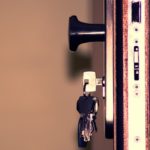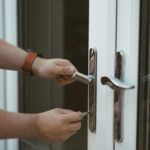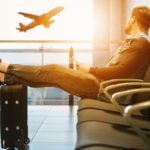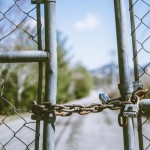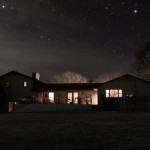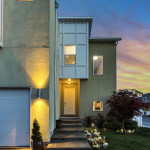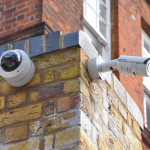Security Tips For Your Home
Summer is here and many of us are planning and going on vacations, leaving homes unoccupied and prime targets for burglars. Don’t be a victim – be sure your home is protected whether you are work or away on a trip. Here are a few simple ways to keep your home safe this summer and year-round.
- Lock Doors & Windows
It should be a habit by know, but sometimes we may forget. Before leaving your home or going to bed, be sure to lock the doors and windows of your home. Some smart home devices may even allow you to lock your doors remotely in case you forget, or if an authorized guest needs to access your home while you’re away. - Use A Home Security System
A home security system is a great defense against burglaries. The mere presence may make burglars think twice about targeting your home. These days, there are various systems available to suit different homes and budgets. If you need assistance choosing the right system for you, give us a call 888-203-6294. - Check The Locks
Much like every other area of your home, locks need maintenance, too. For the best security, install deadbolt locks on outside doors, and use the appropriate locks on sliding doors. Don’t forget to secure any pet doors before leaving as well. - Always Occupied
Your house should always appear occupied, whether you’re home or not. If you are away, use a timer to turn lights on and off to make it appear that someone is home. - Reduce Shrubbery
Don’t make it easier for burglars to hide on your property. Keep your shrubs and trees trim, especially those near upper levels and windows. - Secure Your Garage
Secure your garage like you do with your home. With the exception of detached garages, the garage has an entrance into your home and is a common target for burglars because it is often overlooked. The door leading to your garage should have a lock (a deadbolt for added security) and it is wise to park inside to make it hard to tell whether you’re home or not. - Lights
Use exterior lights to illuminate your perimeter. Motion sensing lights can be helpful for dark areas of your lawn, too. - Mail
If you’re going n vacation, stop your mail delivery or have someone pick it up. Built up mail is a tell tale sign that no one is home. - Outdoor Wires
Telephone lines and electrical wires should not be easily accessible. If these are exposed and easy to get to, intruders will attempt to disarm systems by cutting the wires. - Change The Locks
If you lose your keys, move to a new home, or have someone move out of your home, change the locks on the doors.
Share your home safety hacks with us on Facebook, Twitter, LinkedIn, and Pinterest. You can browse our stock of quality surveillance equipment and security cameras online at SecurityCamExpert.com. Contact us at 888-203-6294 to request a free quote or schedule a site survey.
Secure Your Home
When was the last time you evaluated your home security? With summer, and likely a vacation or two, around the corner, now is a great to time reassess your home security measures and upgrade or improve them as needed.
Doors
A surprising amount of burglars enter homes through the front door, so be sure that all of your doors (especially the front door) are strong and secure. Inspect the door frame, ensure the hinges are protected, and if your door has a mail slot, make sure someone can’t reach through and unlock the door.
To further safeguard your doors and entryways, you can install a deadbolt and/or add a strike plate. You can even upgrade to smart locks or install a doorbell camera. And if you have any sliding glass doors, remember to reinforce them by using a window bar or dowel in the track. Or you can invest in a door sensor or glass break sensor, which will alert you if the door is opened or tampered with.
Windows
Another common entry point for burglars is windows. And unfortunately, window latches and locks can be flimsy and rather ineffective. To better secure your windows, install improved locks or key-operated levers, or implement window bars. You can even reinforce the glass with window security film and install window or glass break sensors. In addition, you can plant prickly bushes under first-floor windows, but be sure to keep them trimmed.
Lighting & Landscape
Intruders want to be as inconspicuous as possible, so why not shine a light on them? Outdoor lighting can help to keep burglars at bay. Light up your yard (front and back) and pathways and place lights near the garage or other outdoor structures. Motion-activated lighting, solar-powered lights and timers can be helpful as well.
While the lights help to prevent burglars from hiding in the darkness, maintaining your landscape plays an important role, too. Be sure that trees and shrubs are trimmed down to eliminate any hiding spots. If there are trees near windows, remove them or add extra security to those windows. And remember to put away stools, ladders, and other tools and lock your gates and sheds.
Garage
An attached garage offers another way to access your house. But even if it is detached, burglars know there’s likely good stuff stored in there. You should always lock all doors to the garage, both interior and exterior. Consider keeping your garage door opener in the house. That way, a burglar can’t steal it from your car. You may even consider upgrading to a smart garage door opener, which alerts you when the door is opened or closed and enables you to control it remotely.
Wi-Fi Network
Securing your home wireless network is also an important part of your overall home security. To keep hackers off your home network, be sure to secure your wireless router and enable WPA (Wi-Fi protected Access) or WPA2 encryption. You should also rename and hide your network, use a firewall, install antivirus and anti-malware protection, and always create strong passwords and change them periodically.
Security System
These days, you can find a home security system that suits your needs and budget. Depending on your unique situation, you may consider DIY versus professional installation, along with the upfront and monthly costs, and the different features offered.
If they are not part of your security system, you may want to install security cameras outdoors, indoors, or both. Some features to look for include remote access, motion detection, night vision, and Wi-Fi capability. If you need assistance, you can visit SecurityCamExpert.com or call us at 888-203-6294.
Your security is our priority. Contact us to learn more about our products and installation services, site surveys, or to request a FREE quote! You can also connect with us on Facebook, Twitter, LinkedIn, and Pinterest.
Safeguard Your Property
Spring is almost here! With warmer weather on the horizon, many of us may have vacations or weekend getaways planned. Before you leave your house unattended, make sure you’re doing your best to keep your home secure. Here are some helpful home security tips to safeguard your home and property.
Maintain Landscape
Your landscape can be an asset or a weakness to your home security, depending on how you utilize it. To protect your property, you want to limit the potential hiding places that your shrubbery can provide. Consider planting thorny bushes under your windows and be sure to keep them trimmed. You may also want to install motion-activated lights along your landscape to further discourage intruders.
Deter Porch Pirates
While online shopping is convenient, it leaves you susceptible to porch pirates. If you’re having packages delivered to your doorstep, work with the delivery companies to improve security. You can request a text when a delivery is made, require a signature upon delivery, or ask for packages to be left in a less prominent location. Another way to deter package theft is to install security cameras at your front door and around your home to monitor activity.
Hide Valuables
You don’t want anyone passing by your street to be able to see all of your valuables. Instead, arrange your furnishings in a way that they are less visible from the street-side window. Also, keep your garage openers and car keys out of sight from any window. Store these in a cabinet or drawer to keep them hidden.
Reinforce Entry Points
You want to be sure that any point of entry, whether window or door, has the proper protection. Exterior doors should be metal or solid wood and at least 1 ¾ inches thick. Protect your windows with locks or burglar-resistant glass, and reinforce sliding doors with a metal bar. A security alarm can also be beneficial by alerting you when a door or window opens as well as alerting authorities when your system is breached.
Practice Safe Behaviors
Personal habits can play an important role in your home security. Make it a habit to lock your doors and windows and arm the security alarm system whenever you leave. If you’ll be gone for more than a few days or on an extended vacation, you should make it look as if your home is occupied. Leave blinds as they would be usually, plan to defer your mail and other deliveries, and use light timers and smart home devices in different areas of your home. Bonus tip: If you are leaving your keys with a parking attendant, remove your house keys – tech-savvy thieves can duplicate your house keys by simply taking a picture of it.
Share your own home security tips with us and your peers on Facebook, Twitter, LinkedIn, and Pinterest. Browse our wide selection of CCTV security cameras, video surveillance systems and more at SecurityCamExpert.com or call 888-203-6294 today!
Choosing Security Cameras
The holidays are here and heightened home security may be on your mind. The potential for theft or vandalism is always present, regardless of your “safe” neighborhood. Protect your loved ones and your property with a security camera system tailored to your needs.
Getting Started
Before you start shopping around, it’s best to evaluate your security needs. Will you be using your security cameras indoors, outdoors, or both? Do you need a specific area covered, such as the front door, or would you prefer complete coverage of your property?
You also want to consider how you will use your cameras. IP security cameras enable remote access as the feed is broadcast over the Internet, and are a great option if you need to access your feed throughout the day while you’re away. You may also allow other people to view the feed (ex. roommates, family).
Once you have a good understanding of what you want and need, the next step is finding the security solution that fits. One thing that is a must for all security camera systems is quality night vision. You should be sure that video recordings are high quality enough that you can identify faces or license plates during the day or night.
Battery-Powered Cameras
Battery-powered security cameras can operate as standalone units, making them an ideal choice for those who do not need multiple cameras. Because they can be single-camera systems, they are usually more cost-effective than other surveillance options. They are also easy to install as they do not require running any wires or any physical modification to the location in which they are installed (with the exception of some models that require mounting screws to a base). This allows for convenience and flexibility, making it easy to relocate these cameras with minimal trouble.
These cameras are a smart option for apartments or rental properties, and most of these cameras provide special features such as motion detection alerts, automatic recording or motion, audio recording, or even two-way audio communication.
You should keep in mind that these security cameras will require a change of batteries from time to time. Also, these are often Wi-Fi IP cameras and require a stable internet connection for proper transmission and functioning. Without a stable network connection, video quality and access of your feed remotely via app may be compromised. In addition, you may need to factor a cloud storage fee in to your budget, depending on the camera you choose.
Hybrid Cameras
Hybrid security cameras are Wi-Fi cameras that operate via AC power cable, therefore, do not need to have batteries changed, and can be placed anywhere with a rare need to be accessed again.
Because they require AC power, they need to be placed relatively close to an outlet. And if you are looking to install a multi-camera system, this needs to be considered as you should have one available plug per camera and enough cable to reach the unit.
Much like the battery-powered units, these IP cameras transmit the video feed over the Wi-Fi network so they require a strong connection. The difference, however, is that some hybrid models use a local hard drive to store footage, allowing you to bypass cloud storage and fees.
In addition, these cameras may offer motion detection push notifications and recording, as well as audio recording and real-time two-way communication.
Wired Surveillance Cameras
Hard-wired cameras offer the greatest stability since both their power and video feed are transmitted via wires instead of battery or Wi-Fi. Because of this, these surveillance cameras are ideal for areas with high signal interference or unstable connectivity.
Some models provide Power over Ethernet (PoE), which means power and video are both transmitted through the same, single wire. This is helpful for those looking to install multi-camera systems for the entire home as it cuts down on numerous long distance cable runs. But in comparison to the battery-powered and hybrid solutions, these cameras require a more involved installation process thanks to the cables and wiring.
On the upside, wire transmission enables the file size and quality to be significantly higher (up to 4K). Because these are typically multi-camera surveillance systems, they are best suited for outdoor application or whole home or business solutions.
As far as storage, these systems require hard drives to compile and store the footage from various feeds. Storage requirements will depend on your individual needs. You must consider file size as well as how long you want to store your footage before it is overwritten.
If you need help determining how much storage you will need, or simply need help choosing the right surveillance system for you, please contact us 888-203-6294 or visit SecurityCamExpert.com. You may browse our selection of top quality security cameras and surveillance equipment, or inquire about our installation services, site surveys, or request a free quote! You may also connect with us on Facebook, Google+, Twitter, LinkedIn, and Pinterest.
Home Security: Mistakes To Avoid
You may think you are taking all the necessary precautions to keep your home safe, but you may be unaware that you are making some simple mistakes. Here are some common missteps that may be putting your home at risk.
- Location
Sometimes the location of your house can influence your risk for burglary. If your home is located on a busy street with high-visibility, you have less chances of your home being targeted – there’s simply too much risk of being seen and caught in the act. Unfortunately, better burglary targets are townhomes, houses in the middle of the block, and homes on cul-de-sacs. If your property backs up to a forest, open lot, or other unguarded area, be sure to take the necessary precautions and install high fences and lots of lighting. - Garbage
Did you know electronics are second to cash when it comes to the things burglars look for? Don’t leave big boxes from your expensive electronics visible from the street. This is a telltale sign that you’ve got shiny, new electronics ripe for picking. Take the extra time to break down the boxes and make sure labels cannot be seen. - Mail
An overflowing mailbox is a sure sign that someone is out of town. The same goes for newspapers piling up on your driveway. You can arrange for someone you know and trust to pick up your mail or place a temporary hold on your mail and newspapers while you’re away. - Yard
Your yard can give away many clues as to what may be inside your home. Before you go on vacation, be sure you have mowed the lawn and trimmed your bushes and that you have a plan to upkeep these appearances until you return home. Burglars will pay attention to uncut lawns, and overgrown bushes allow for a place to easily hide. In addition, if you live in an area where snowfall is possible, arrange for someone to create car and foot tracks into the house.If your children’s toys are left out, they are at risk of being stolen, and they give burglars insight to what type of valuables they may find inside. With children present, there may be an expensive gaming console or other electronics, and mommy and daddy may have expensive jewelry hidden away inside.Lastly, you don’t want to make it easy for thieves to access your home so be sure to put your ladder and tools away and refrain from leaving stools or chairs in your backyard. This makes it easier for them to gain access to a second story window that may not be locked. - Lock Up
Speaking of locks, more often than not, burglars enter homes through unlocked doors and windows. So it is worth mentioning – Do not forget to lock your doors and windows. And that goes for all doors or entryways, such as the front and back doors along with the garage doors. Whether your garage door leads into your home or backyard, be sure to lock it because the bad guys will try anything and everything to get to your valuables.And because they will try anything, do not forget to secure your dog door while you’re away. And you may forget, but it’s smart to secure patio doors as well since they are fairly easy to pick. The easiest and most inexpensive way is putting a heavy duty stick in the door track, however, there are locks which fasten along the top and bottom of the door and are less of an eyesore and inconvenience. - Windows
Much like doors, windows provide another point of entry, albeit less convenient. You may want to crack a window to cool down the house without cranking the A/C, however, if you neglect to close it when you leave, you are making is too easy for someone to enter your home. Along the same lines, if you have a window A/C unit, it is easy for thieves to knock it out and climb in through the window.Aside from locking them, you should consider the visibility of the inside of your home from your windows. You should leave a mix of open, partially open, and closed blinds, but choose wisely. Avoid leaving blinds open near your valuables and electronics. Leaving some blinds partially open allows for some privacy and security while letting interior light out, and vice versa. - Keys
Leaving a spare key around in case of emergency is a good idea in theory, however, thieves are often privy to the usual hiding spots. If you must hide a spare key, avoid the obvious areas and think outside of the box.Additionally, don’t keep your keys on a hook next to the door nor should they be visible from outside. And do not keep your garage door opener in your car. Whether your car gets broken into at home or elsewhere, the burglar knows your address is printed on the registration card. Invest in a keychain remote for added security. - Visitors
Be wary of those you invite into your home. Whether they are friends of friends or hired help, word can spread quickly about what’s inside your home. While those who enter your home may not be thieves themselves, they may pass information along to someone looking for some quick cash. - Social Media
Social media is a tricky thing. While you want to share highlights from your vacation with friends and family, be sure you are being smart about it. Refrain from posting those vacation photos as it clearly tells others that you are away from home, making your property a prime target. Instead, be sure your profiles are not public and wait to post those vacation pictures until after you have returned home.
Do you have any other home security tips to share? Connect with us on Facebook, Google+, Twitter, LinkedIn, and Pinterest.
For an affordable, quality home security system, visit SecurityCamExpert.com or call 888-203-6294! We are happy to provide you with a free quote, schedule a site survey, or assist you with any questions you may have.
Risky Home Security Measures
Home security measures are meant to protect you from unwanted intruders, but sometimes these measures can backfire. Here are some common home security measures and mistakes you should avoid.
Privacy Gates & Fences
While these may be put in place to preserve your privacy, they can actually provide cover and hiding spots for burglars. Intruders can benefit from the privacy provided and work on forcing entry into your home unseen.
While every house and property is unique, try to plan your fencing in a way that allows the main entryway to be visible from the street. Since doors are a common entry point for burglars, this can help to make it more difficult for criminals to gain access without being detected.
Hidden Keys
These are helpful if you have people checking in on your home or in the event you accidentally lock yourself out. However, most homeowners choose obvious spots for hiding keys, which burglars are keen to and will immediately check.
Generally it’s better to hide the house key further from the home in less obvious spots. And a disguised item, such as a rock, is only useful if hidden among similar items.
Bushes
Your landscaping can make your home more or less friendly for intruders. If you have bushes or trees right up against the side of your home, they can provide cover in the same way that a fence might.
You don’t have to give up on your plants all together, but it is important to keep their placement in consideration. Choose low-height or thin-growing shrubbery immediately beside your home while keeping denser and taller plants further out.
Static Lights
Most homeowners install outdoor lighting for home security, whether they turn them on at the end of the day, or place a timer or light sensor so that they turn on automatically at night. These lights provides illumination for the yard, however, these can also create dense pockets of shadows that make for great hiding spots.
Motion sensor lights are a better alternative. They will provide outdoor lighting while shocking anyone who is prowling around your property. Motion sensor lights will also be used less often, resulting in lower electrical bills and longer lived light bulbs.
Valuables
We often forget that windows work both ways, thus intruders can see inside our homes. This is precisely why we should never leave our valuables in plain sight. Especially on the ground floor, be mindful of things like jewelry that may be left out on dressers and possibly visible from the windows. Televisions may be hard to position out of view, so remember to pull the shades or blinds shut in the evening.
Packaging Disposal
Packaging from an expensive item, such as a television or laptop, should not be set by the curb. This tells thieves that there is an expensive item in your home. Instead, take time to break down the box and cut it into smaller pieces to disguise what it once held.
Alarm System
Alarm systems are a smart tool, but be sure that your installers mount the control pad in a location that is not visible from a first floor window. Potential burglars may be able to see whether or not the alarm system is activated. This is especially true at night when the green or red status light is clearly visible in a darkened home.
Social Media
Social media is a fun way to stay in touch with friends and share travel experiences, but it should be done after the trip.
Because social media is mostly a public platform, you don’t want to announce to the world that you’ll be out of town. Burglars can easily search common keywords (ex. trip, travel, vacation) to potentially find out when homes will be empty.
To avoid this, share your wonderful photos and stories about your trip after you return home. IF you must share, be sure you are sharing it privately so only your close friends and family can see.
Mail Pileups
Piled up mail and newspapers scream that homeowners are away, and this is visible to anyone who simply drives by your home. Before you leave, contact your local post office and/or newspaper to temporarily suspend service. Or you can ask a friend or neighbor to pick up any mail or newspapers while you’re away. Activity around the front of the home will help to make your home look occupied as well.
Ladder Access
Most of these tips have addressed first-floor issues because it’s much more difficult to break-in through the second story. However, some homeowners may not know that they are providing simple and easy access to their second floor. Refrain from leaving your ladder in the yard where it can be easily seen and used by burglars. Instead, store it away in a garage or locked tool shed.
Assuming Daytime Is Safe
Break-ins are often associated with nighttime, but daytime break-ins are quite common. This is because burglars prefer an empty home, and during the day, most occupants are at school or work. With that said, the appropriate measures should be taken. Whenever you’re away from home, day or night, remember to turn your alarm systems on, keep an eye out for suspicious activity, and close and lock all doors and windows.
Do you have any other home security tips to share? Connect with us on Facebook, Google+, Twitter, LinkedIn, and Pinterest.
Visit SecurityCamExpert.com to browse our extensive selection of quality security cameras, CCTV surveillance packages and security equipment for your home or business. If you have any questions or would like a free quote, please feel free to contact us 888-203-6294.
Protect Your Home
As we embark on the summer season, home security is emphasized. The long days and warm weather call for later nights, weekend getaways, and vacations. Whether you stay home or not, up your home security with these helpful tips.
Exterior Doors
With several different points of weakness (ex. handle, lock, hinges, frame) an exterior door is a common target for burglars. Sliding doors and French doors present even more weaknesses.
- Invest in a sturdy deadbolt lock – the spring-latch lock on your door handle is easily compromised.
- Install door armor kits on exterior doors, which usually include 3″ screws to replace short screws that come with door hardware, hefty strike plates for handles and deadbolts, and metal framing to place around the hinge and handle/lock hardware. This helps to reinforce the weak points of your door and safeguard against intruders.
- Add auxiliary locks to sliding doors, such as loop locks, security bars ( also known as sliding door polls or Charlie bars), or vertical bolt locks.
- Add a security bar to French doors to prevent kick-ins. While they may not be visually appealing, they are effective.
- With French doors, and most doors in general, make sure all of your hinge pins are interior-facing to avoid giving burglars easy access without force.
- Glass doors should be enforced with security film. This prevents glass from being easily broken.
Windows
Luckily, there are numerous ways to increase window security, whether they are old or you are installing new windows.
New windows:
- Choose reinforced (tempered or laminated) glass or acrylic (polycarbonate) windows. These are much harder to break than traditional glass windows and can help deter criminals from continuing after the first attempt at breaking in.
- Choose multiple panes of glass instead of one large pane. Multiple glass panes provide added strength and durability.
Old Windows:
- Add after-market window locks to your built-in window locks. These provide an easy and inexpensive way to prevent windows from being forced open. Depending on the style of your window, you may need double hung window locks, sliding window locks or locks for casement windows (sometimes called crank windows).
- For additional protection, exterior windows bars may be added. Aside from protecting your windows, most of these window bars come in decorative designs to accent the style of your home.
- As previously mentioned, security film can be added to windows to decrease the likelihood of break-ins (thicker film provides the highest level of protection).
Garage Doors
Unfortunately, an attached garage door can be easily compromised, and garage door security is often overlooked. What is especially troubling is that after gaining access, burglars can quickly shut the garage door behind them and take their time rummaging through your home without being seen.
- Refrain from leaving garage door openers in your vehicles. It may seem inconvenient, but it is worth the security.
- Secure your garage door emergency release to prevent easy intruder access. You may fasten it with a zip tie (which can be broken by yanking the release cord) or place a barrier between the top of the door and the release.
- A garage door sensor can alert you when your garage has opened. Newer garage door openers have this feature built-in as well as an auto-closing feature that will close your garage door after a long period of time.
- A deadbolt on the door between your garage and home will help to prevent further intrusion. You may want to also install a peephole viewer on this door to make it easier to inspect the garage without opening the door.
- Install a bright, motion sensing light in the garage to bring attention to an open garage door.
Make Your Home Look Occupied
Regardless if you are home or not, you want to make it look like your home is occupied. An unoccupied home is a prime target for burglars.
- Use strategically placed lights and lamps with timers. Lights turning on and off in different rooms will make it appear as if you are home.
- Leave a television or radio on at moderate volume. Noise will make criminals think you are home, and the light from the television mimics activity.
- Leave some curtains or blinds open. This is helpful if you are using light timers or a television to cast light. It can also be helpful should police or a neighbor need to take a look into your home.
Perimeter Security
Some of the best tactics are not thought of as prevention techniques.
- Get a dog. A barking dog may make enough noise to bring attention to an approaching burglar and deter them from proceeding.
- Invest in a home security system and signage. This may deter them from targeting your home, and if it does not, you know your home is protected and that police will be alerted in a timely fashion.
- Outdoor lighting is a great way to keep intruders away. Darkness allows intruders to sneak around your property unnoticed, but dusk-to-dawn porch lights and motion-activated lights around your perimeter help to increase visibility.
- Keep a car parked in the driveway. This makes it seem that someone is home.
- Maintain your landscape and keep bushes and shrubs near windows trimmed to minimize hiding spots. You may even consider planting thorny or spiked plants (ex. blackberry bushes, holly, juniper) to prevent burglars from getting too close.
Have your own tips to share? Connect with us on Facebook, Google+, Twitter, LinkedIn, and Pinterest!
Need help finding the right home security system for you? Visit SecurityCamExpert.com to browse our selection of surveillance systems or call 888-203-6294 today!
Tips For Improving Your Home Security System
Home security camera systems help home owners protect their property and loved ones. They provide an extra set of eyes to monitor your home whether you are at home or away. Because of the financial investment, it is important to ensure that everything is working properly.
There are many ways in which you can optimize your surveillance cameras to get the most out of your security system. Here are a few smart security tips to improve your system.
Use Motion Detection
A security camera that is recording everything all the time sounds good in theory, but will require a large amount of memory and power. It will also be more difficult to sort through the mundane footage to find what you are looking for.
Thanks to motion detection, your camera does not have to record all the time. Motion detection enables your camera to start recording when activity in the field of view triggers the sensor. This means you will not need to worry about running out of storage space and makes it easier to sort through your recordings.
Consider Location
Choosing the right location for your security cameras is crucial. Be sure to adjust the angle of your camera to maximize your field of view and ensure that obstructions, such as trees or bushes, do not block the camera’s view.
Other Home Security Solutions
Although security cameras are important, they cannot do everything. Pairing your security camera system with a high quality and reliable alarm system can increase your home security overall and may even help with insurance discounts.
Multiple Cameras
While an outdoor security camera is common, often times, one camera is not enough. If there’s only one security camera present, it’s likely that burglars will work around that. You want your security cameras to monitor high traffic areas and points of entry (ex. front door, back door, first floor windows). That way, you get more comprehensive video surveillance should you become a target for home invasion.
Proper Maintenance
You can’t just set it and forget it when it comes to your surveillance system. Keeping your cameras clean and any potential obstructions at bay will help maintain the performance and effectiveness of your system. Skipping routine maintenance checks may cause your cameras to miss important moments.
Do you have any other home security tips? Share with us on Facebook, Google+, Twitter, LinkedIn, and Pinterest.
For a great selection of affordable security cameras and CCTV surveillance camera systems, please visit SecurityCamExpert.com. For more information about our installation services or to request a free quote, please call 888-203-6294.
Motion Detection: How It Works
Security cameras equipped with motion detection can be very helpful for home and business owners. Motion sensor cameras allow users to rest easy knowing the built-in sensors will alert them when activity is detected, eliminating the need for monitoring live feeds around the clock.
While motion detection can be very convenient, it can also prove to be a nuisance. False alarms caused by various reasons, such as pets, natural environmental changes, or even changes in lighting, can be frustrating, confusing, and a waste of time. In order for you to make the most of the motion detection feature, here’s what you need to know.
Types of Detection
While there are many different technologies that detect motion (ex. light pulses, thermal measurements, radio waves), for consumer security cameras, there are two methods that are commonly used.
Passive Infrared (PIR)
This method detects the ambient heat emitted by all living beings and is sometimes referred to as “heat vision.” The sensor is triggered when it detects enough movement of these warm “objects” and/or a significant temperature disparity between the object and the background scene. When triggered, it signals the security camera to start recording, and thus, the user is alerted.
Computer Vision (CV)
This approach involves camera software that analyzes sequential frames of live video for differences and registers a motion event when a significant change is detected. With that said, CV includes many different methods, which depend on the desired outcome and technical preference of the designers.
Of these methods, one of the easiest involves looking for a significant change in pixels over short periods of time compared to the longer term average. This will produce a simple ‘something happened’ signal. Another method tracks groups of pixels and tries to identify directional patterns in order to recognize moving objects.
What all of these methods have is common is the end goal – to detect motion and, if possible, determine the shape of the object that moved. Once that goal is achieved, more advanced methods can be applied to classify the moving object (ex. person, animal, vehicle, tree) to determine which detection signals are important (ex. person or vehicle) or irrelevant and can be dismissed (ex. animal or tree).
Pros & Cons
- PIR sensors are more reliable than CV-based cameras when it comes to filtering out insignificant activity (ex. curtains fluttering in the breeze from a nearby fan, change in the light streaming through a window)
- PIR is power efficient, thus often used in battery-powered cameras. PIR keeps these cameras them in a low-power, non-recording state until the PIR sensor detects motion. When motion is detected, they switch to a high-power recording state for a fixed period of time (ex. to capture a 30 second video clip) or until motion stops.
- The low-power mode of PIR can be a disadvantage as it may take more time to wake up and start recording than CV-based cameras. Consequently, you may miss part of the action that triggered the motion alert, such as the intruder’s approach when their face is most visible, which matters with forensic evidence. By nature, they are also incapable of detecting motion through glass, thus are not suitable for scenarios such as monitoring your yard with an indoor cameras aimed through a window.
- CV motion detection provides greater analysis of the scene and for identification of the object creating motion through advanced features (ex. person detection, facial recognition). However many of the algorithms that make this possible are too computationally intensive to run locally on the camera. Instead, they are computed on remote servers in the cloud, where they often can only be unlocked with a paid subscription, which can add significantly to the total cost of ownership of the camera.
- Because CV detection is also dependent on the quality of the algorithms, it is also more susceptible to false alarms. That is, any large change (ex. spinning ceiling fan, leaves blowing outside window, change in ambient lighting) can register as motion.
False Alarms
Of course, false alarms are one of the most frustrating downsides to motion detection. Luckily, manufacturers are aware of this and offer different ways to reduce these instances.
- PIR cameras usually allow users to adjust the sensitivity level within the accompanying app so that more- or less-pronounced motion triggers the sensor. For example, reducing the sensitivity level could require a moving object to be warmer or closer to the camera for it to be triggered.
- CV offers more options for combating false alarms. A popular option is to set motion detection zones, which basically allows you to tell your camera to ignore activity in certain parts of the field of view while focusing on specific areas for motion. This approach is fairly effective as your camera can focus on windows and doors (where breaches are most likely to occur) rather than the activity within your home.
- Based on the geometric properties of a moving object, CV is able to make quick judgment calls. For example, something very small relative to the field of view is either a small object (ex. a floating dust mote) or a larger object far away, both of which are not cause for triggering any sensors.
- With more advanced technology, CV-based cameras may also include person detection or facial recognition to decrease false alerts. Both technologies require a pre-existing database of recognized individuals and usually require a few weeks of use before accurate results are produced. And while these features are advanced, they are only as strong as the algorithms behind them (which is why different cameras with facial recognition can produce different results).
Motion detection is still a work in progress, and at this point, you likely get what you pay for. The good news is that our technologies are always improving, thus, motion detection has the potential for greatness on the future.
What are your thoughts on motion detection security cameras? Have you had success or failure with them? Share your experiences with us on Facebook, Google+, Twitter, LinkedIn, and Pinterest.
Visit SecurityCamExpert.com to browse our wide selection of affordable CCTV security cameras and surveillance packages. Call 888-203-6294 to request a site survey or free quote today!
Home Security Camera Placement Tips
When it comes to security camera systems, you can invest in the best, most advanced equipment, but choosing poor locations for your security cameras can render your system ineffective.
In order to choose the best placement for your surveillance cameras, you should consider the layout of your property and which areas need monitoring. Most home or business owners target high traffic areas and entryways.
Here are more helpful tips for installing your security cameras.
- The most commonly targeted entryways are the front door, back door, and first-floor windows, so be sure these are under video surveillance.
- In addition, a security camera at the front door can act as a digital peephole since you can access your live feed to see who’s at the door. You can place it above the door or window frame facing downward so that it covers the area a few feet in front of the opening. Or you can place it inside your home on the window sill overlooking the front yard.
- The type of camera will also help determine where it should be placed. Surveillance cameras with a focus range of around 45 to 75 degrees should be aimed at specific areas (ex. doorway, garage). Wide angle cameras should be placed where they can view 75 to 180 degrees without any obstructions. For security cameras that can rotate, be sure to check with the manufacturer for information on how much unobstructed viewing area is necessary.
- For surveillance cameras being installed outdoors, be sure they are waterproof, vandal proof, and have night vision capabilities in order to record overnight. Motion detection lights around the perimeter of your home can also help capture quality recordings as well as deter burglars from approaching.
- In addition, when placing security cameras outdoors, you want them to be visible yet out of reach. By installing them at least 9 feet above the ground, you decrease the likelihood of tampering, vandalism, or theft of your cameras.
Do you have any security camera placement advice or tips to share? Connect with us on Facebook, Google+, Twitter, LinkedIn, and Pinterest.
Shop our great selection of quality CCTV security cameras and surveillance systems for your home or business. Visit us online at SecurityCamExpert.com or call 888-203-6294.
